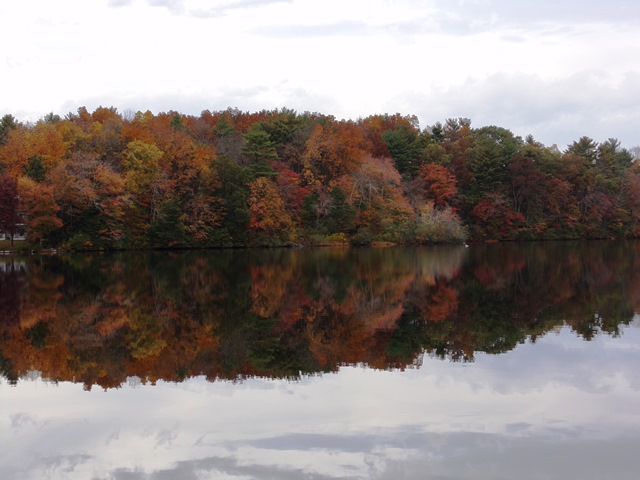We’ve recently completed our 2014 Jacobs Pond Fall Waterfowl Migration Survey. This was the second year of our survey, and with the lack of ice this year between September and the end of December, we had a greater variety of species and a higher number of total individuals sighted in 2014 than we did in 2013. Here are some of the fun stats:
Total birds sighted: 2014: 272
2013: 146
Species: In 2014, ten species of waterfowl graced the pond in some way. One was a complete flyover that thought about landing but kept moving, a Common Loon that slowed when approaching the pond from the north, noticeably cocking its head to look below, then speeding up and continuing its southward migration. The other nine either appeared in flocks, family units or as individuals. Only seven species appeared in 2013.
| Species | 2014 | 2013 | 2014 Notes |
| Canada Goose | 84 | 83 | |
| Ring-necked Duck | 74 | 24 | Obvious migrants; 4-week sequence was 23, 22, 15, 4 |
| Mute Swan | 64 | 28 | 16 sightings of the same 4 birds |
| Hooded Merganser | 22 | 6 | |
| Mallard | 15 | 3 | |
| American Black Duck | 10 | 0 | First migrants of the season, all in one flock |
| Bufflehead | 9 | 1 | |
| Common Loon | 1 | 0 | |
| Pied-billed Grebe | 1 | 0 | |
| Ruddy Duck | 1 | 1 |
Of note is the arrival of the Pied-billed Grebe. One was seen in the spring as well. This is significant, worthy of being noted, because the species is listed as Endangered in Massachusetts.
Three of the ten species listed in 2014 counts breed on or near the pond, and are generally year-round residents, as long as the pond remains open: Mute Swan, Canada Goose and Mallard. The other seven are migrants or winterers. In 2014, the first migrants, a flock of ten American Black Ducks, appeared on September 30 (while American Black Ducks are permanent residents of Massachusetts, their breeding numbers have crashed). Hooded Mergansers were the only migrants left as of the final count of the year on December 26.
Usage: Interestingly, the ratios between feeders, resters and travelers was almost exact between the two years:
| Activity | 2014 | 2013 |
| Feeding | 103 (38%) | 53 (36%) |
| Resting | 162 (60%) | 88 (60%) |
| Traveling | 7 (1%) | 5 (3%) |
These results may reflect the times of day the surveys were taken (roughly 7:45-9:30), or may simply be random, in that weather conditions impacted conditions as well.
A survey like this is only valuable when run for a long period of time, or in multi-year chunks (e.g., for three years out of every ten, to establish comparable data sets over time). We will continue with this survey next year to help flesh out the story of the waterfowl life on Jacobs Pond. Projects like this one help us to understand what it is we should be teaching the many students, scouts and others who come to us for nature programming throughout the year.
